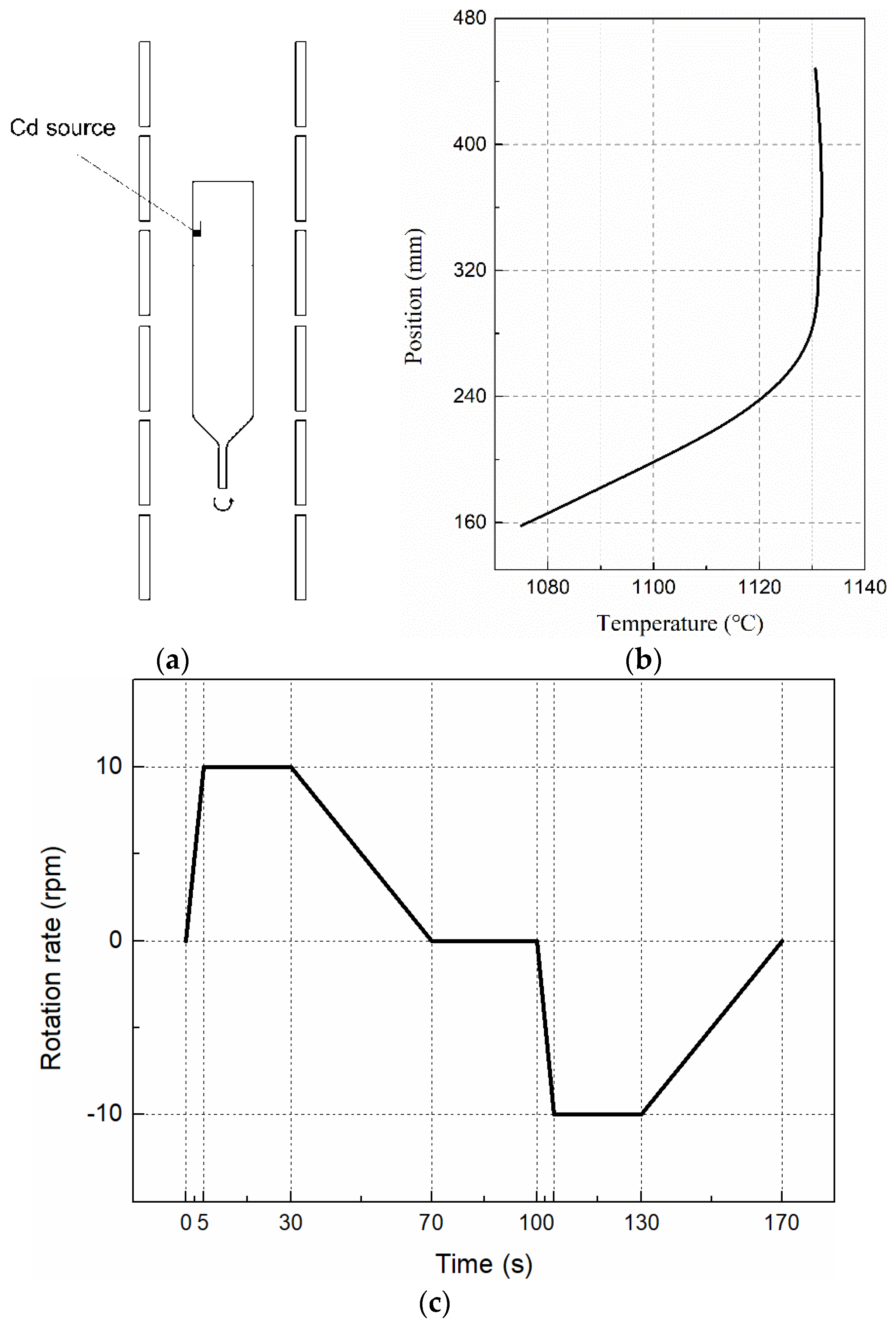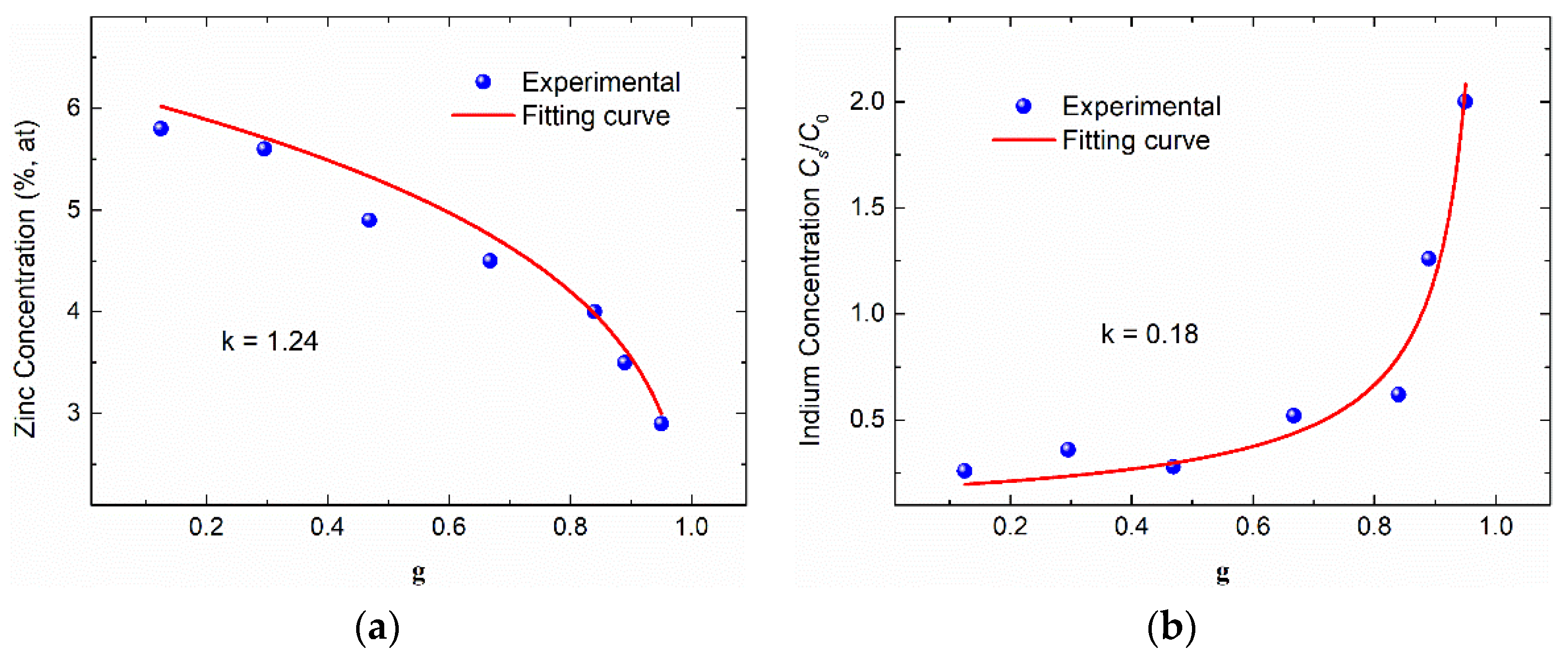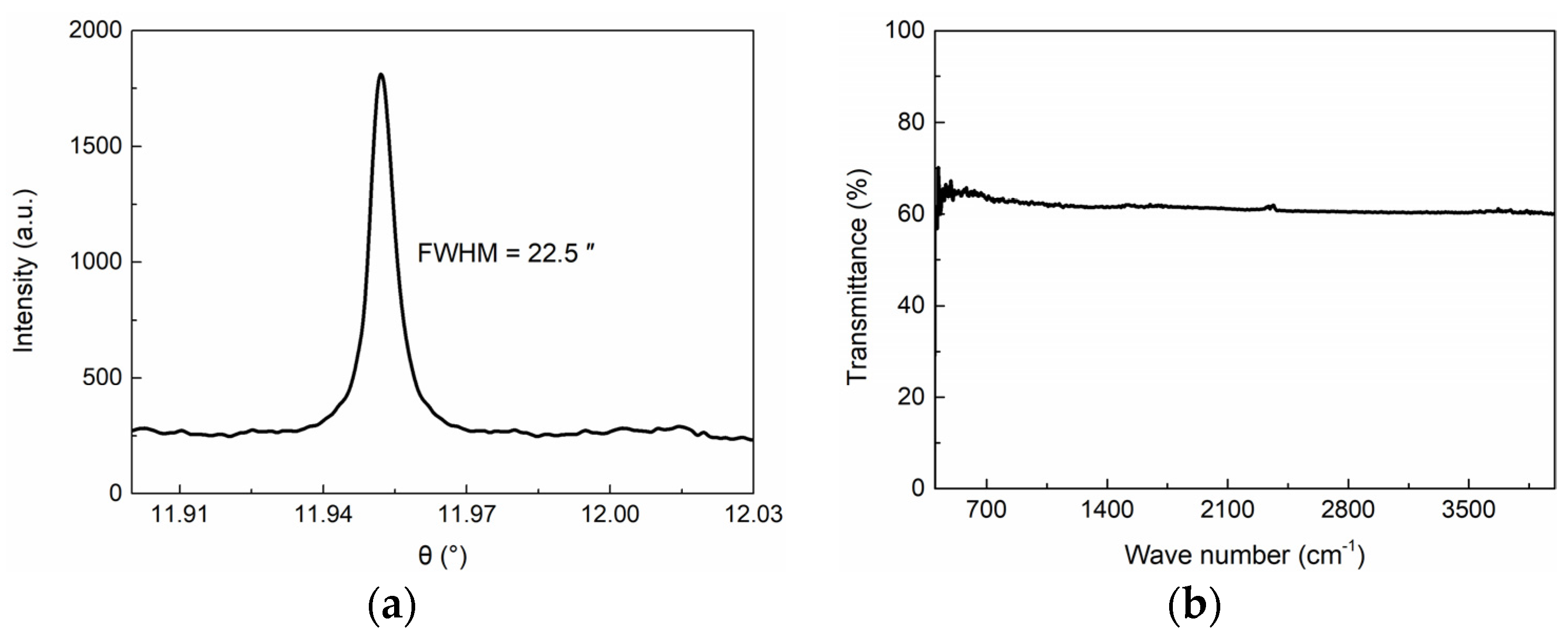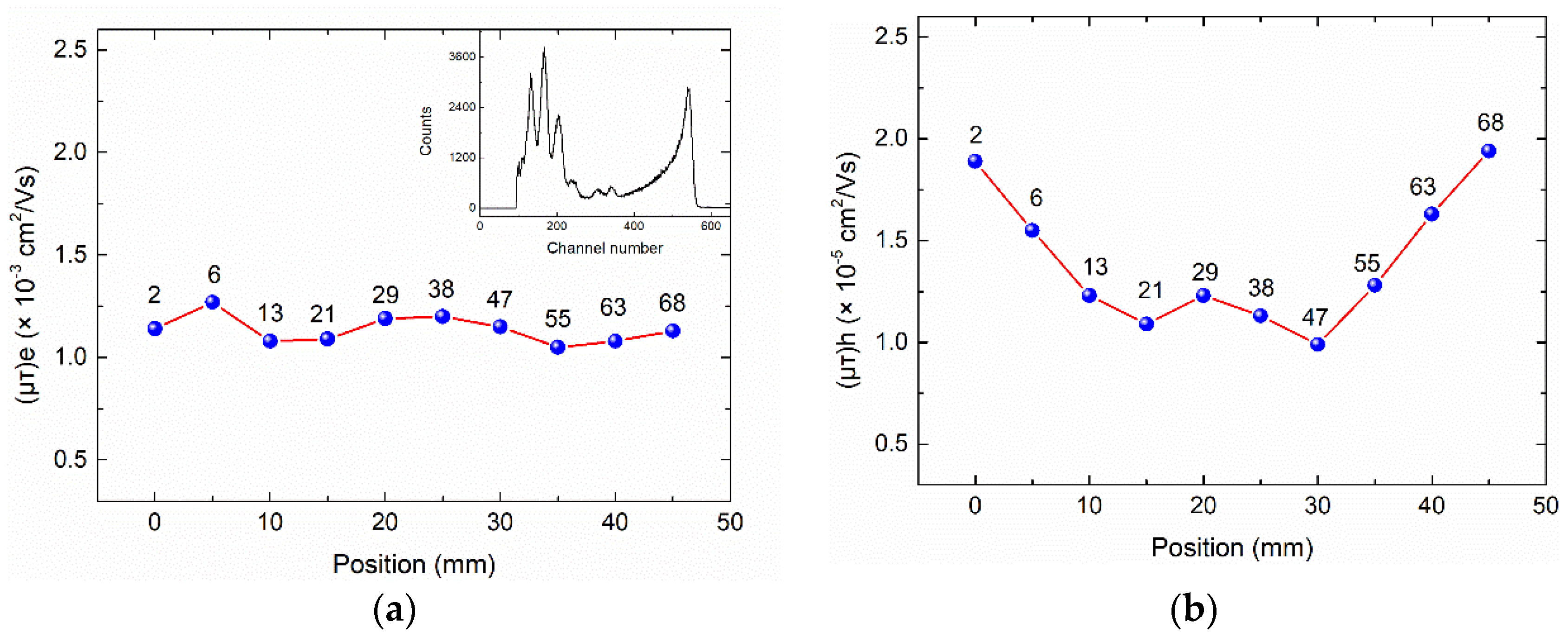Growth of Single-Crystal Cd0.9Zn0.1Te Ingots Using Pressure Controlled Bridgman Method
Abstract
:1. Introduction
2. Cd0.9Zn0.1Te Single-Crystal Ingot Growth
2.1. Synthesis
2.2. Crystal Growth and In-Situ Annealing
2.3. Crystal Growth Results
3. Characterization of as-Grown Ingots and Discussion
3.1. Concentration Segregation
3.2. Crystallinity and Second Phase Characterizations
3.3. Radiation Response
4. Conclusions
Author Contributions
Funding
Conflicts of Interest
References
- Eisen, Y.; Shor, A.; Mardor, I. CdTe and CdZnTe gamma ray detectors for medical and industrial imaging systems. J. Cryst. Growth 1999, 428, 158–170. [Google Scholar] [CrossRef]
- Carini, G.A.; Arnone, C.; Bolotnikov, A.E.; Camarda, G.S.; De Wames, R.; Dinan, J.H.; Markunas, J.K.; Raphothamachar, B.; Sivananthan, S.; Smith, R.; et al. Material quality characterization of CdZnTe Substrates for HgCdTe epitaxy. J. Electron. Mater. 2006, 35, 1495–1502. [Google Scholar] [CrossRef] [Green Version]
- Schwenkenbecher, K.; Rudolph, P. Investigation of convection in the solution zone at the growth of CdTe by THM. Cryst. Res. Technol. 1985, 20, 1609–1613. [Google Scholar] [CrossRef]
- Rudolph, P.; Muhlberg, M. Basic problems of vertical Bridgman growth of CdTe. Mater. Sci. Eng. B 1993, 16, 8–16. [Google Scholar] [CrossRef]
- Shcherbak, L.; Feychuk, P.; Plevachuk, Y.; Dong, C.; Kopach, O.; Panchuk, O.; Siffert, P. Structure rearrangement of the Cd1-xZnxTe (0 < x < 0.1) melts. J. Alloys Compd. 2004, 371, 186–190. [Google Scholar]
- Chen, H.; Awadalla, S.A.; Iniewski, K.; Lu, P.H.; Harris, F.; Mackenzie, J.; Hasanen, T.; Chen, W.; Redden, R.; Bindley, G. Characterization of large cadmium zinc telluride crystals grown by travelling heater method. J. Appl. Phys. 2008, 103, 014903. [Google Scholar] [CrossRef] [Green Version]
- Zappettini, A.; Zambelli, N.; Benassi, G.; Calestani, D.; Pavesi, M. Live-monitoring of Te inclusion laser-induced thermo-diffusion and annealing in CdZnTe crystal. Appl. Phys. Lett. 2014, 104, 252105. [Google Scholar] [CrossRef]
- Szeles, C.; Cameron, S.E.; Soldner, S.A.; Ndap, J.; Reed, M.D. Development of the high-pressure electro-dynamic gradient crystal-growth technology for semi-insulationg CdZnTe growth for radiation detector applications. J. Electron. Mater. 2004, 33, 742–751. [Google Scholar] [CrossRef]
- Franc, J.; Sedivy, L.; Belas, E.; Bugar, M.; Zazvorka, J.; Pekarek, J.; Uxa, S.; Hoschl, P.; Fesh, R. Mealt growth and post-grown annealing of semiinsulating (CdZn)Te by vertical gradient freeze method. Cryst. Res. Technol. 2013, 48, 214–220. [Google Scholar] [CrossRef]
- Azoulay, M.; Zilber, R.; Shusterman, S.; Goldgirsh, A.; Zontag, I. Growth and characterization of CdTe and CdZnTe crystals for substrate application. Proc. SPIE 2003, 4820, 790–808. [Google Scholar]
- Wang, T.; Ai, X.; Yin, Z.; Zhao, Q.; Zhou, B.; Yang, F.; Xu, L.; Zha, G.; Jie, W. Study on a co-doped CdZnTe crystal containing Yb and In. Cryst. Eng. Comm. 2019, 21, 2620–2625. [Google Scholar] [CrossRef]
- Rudolph, P.; Koh, H.J.; Schafer, N.; Fukuda, T. The crystal perfection depends on the superheating of the mother phase too-experimental facts and speculations on the “melt structure” of semiconductor compounds. J. Cryst. Growth 1996, 166, 578–582. [Google Scholar] [CrossRef]
- Greenberg, J.H. P-T-X phase equilibrium and vapor pressure scanning of non-stoichiometry in the Cd-Zn-Te system. Prog. Cryst. Growth Charact. Mater. 2003, 47, 196–238. [Google Scholar] [CrossRef]
- Yin, L.; Jie, W.; Wang, T.; Zhou, B.; Yang, F.; Nan, R. The effects of ACRT on the growth of ZnTe crystal by the temperature gradient solution growth technique. Crystals 2017, 7, 82. [Google Scholar] [CrossRef] [Green Version]
- Babentsov, V.; Franc, J.; Hoeschl, P.; Fiederle, M.; Benz, K.; Sochinskii, N.; Dieguez, E.; James, R. Characterization of compensation and trapping in CdTe and CdZnTe: Recent advances. Cryst. Res. Technol. 2009, 44, 1054–1058. [Google Scholar] [CrossRef]
- Heffelfinger, J.R.; Medlin, D.L.; James, R.B. Structural and chemical analysis of grain boundaries and tellurium precipitates in commercial Cd1-xZnxTe. Proc. SPIE 1998, 3446, 49–54. [Google Scholar]
- Sheil, E. Bemerkungen zur schichtkristallbildung. Z. Metallkd 1942, 34, 70–72. [Google Scholar]
- Tanaka, A.; Masa, Y.; Seto, S.; Kawasaki, T. Zinc and selenium co-doped CdTe substrates lattice matched to HgCdTe. J. Cryst. Growth 1989, 94, 166–170. [Google Scholar] [CrossRef]
- Yokota, K.; Nakai, H.; Satoh, K.; Katayama, S. Segregation coefficients and activation of indium in cadmium telluride grown from tellurium-rich melt by the Bridgman technique. J. Cryst. Growth 1991, 112, 723–728. [Google Scholar] [CrossRef]
- Weigel, E.; Muller-Vogt, G.; Steinbach, B.; Wendl, W.; Stadler, W.; Hofmann, D.M.; Meyer, B.K. Defects and electrical properties of doped and undoped CdTe single crystals from tellurium-rich solutions. Mater. Sci. Eng. B 1993, 16, 17–22. [Google Scholar] [CrossRef]
- Fochuk, P.; Panchuk, O.; Feychuk, O.; Shcherbak, L.; Savitskyi, A.; Parfenyuk, O.; Ilashchuk, M.; Hage-Ali, M.; Siffert, P. Indium dopant behavior in CdTe single crystals. Nucl. Instr. Meth. Phys. Res. Sect. A 2001, 458, 104–112. [Google Scholar] [CrossRef]
- Parnham, K.; Szeles, C.; Prettyman, T.H.; Smith, M.; Stahle, C.; Parker, B.H.; Wang, L.L. Further studies on the modified two-terminal electrode geometry for CdZnTe detectors. Nucl. Instr. Meth. Phys. Res. Sect. A 2001, 458, 334–338. [Google Scholar] [CrossRef]
- Huang, Z.C.; Eissler, E.; Wie, C.R. Role of cadmium vacancy-related defects in CdTe nuclear detectors. Nucl. Instr. Meth. Phys. Res. Sect. A 1995, 100, 507–510. [Google Scholar] [CrossRef]
- Carvalho, A.; Oberg, S.; Briddon, P.R. Intrinsic defect complexes in CdTe and ZnTe. Thin Solid Films 2011, 519, 7468–7471. [Google Scholar] [CrossRef]








© 2020 by the authors. Licensee MDPI, Basel, Switzerland. This article is an open access article distributed under the terms and conditions of the Creative Commons Attribution (CC BY) license (http://creativecommons.org/licenses/by/4.0/).
Share and Cite
Yang, F.; Jie, W.; Wang, M.; Sun, X.; Jia, N.; Yin, L.; Zhou, B.; Wang, T. Growth of Single-Crystal Cd0.9Zn0.1Te Ingots Using Pressure Controlled Bridgman Method. Crystals 2020, 10, 261. https://doi.org/10.3390/cryst10040261
Yang F, Jie W, Wang M, Sun X, Jia N, Yin L, Zhou B, Wang T. Growth of Single-Crystal Cd0.9Zn0.1Te Ingots Using Pressure Controlled Bridgman Method. Crystals. 2020; 10(4):261. https://doi.org/10.3390/cryst10040261
Chicago/Turabian StyleYang, Fan, Wanqi Jie, Miao Wang, Xiaolong Sun, Ningbo Jia, Liying Yin, Boru Zhou, and Tao Wang. 2020. "Growth of Single-Crystal Cd0.9Zn0.1Te Ingots Using Pressure Controlled Bridgman Method" Crystals 10, no. 4: 261. https://doi.org/10.3390/cryst10040261





